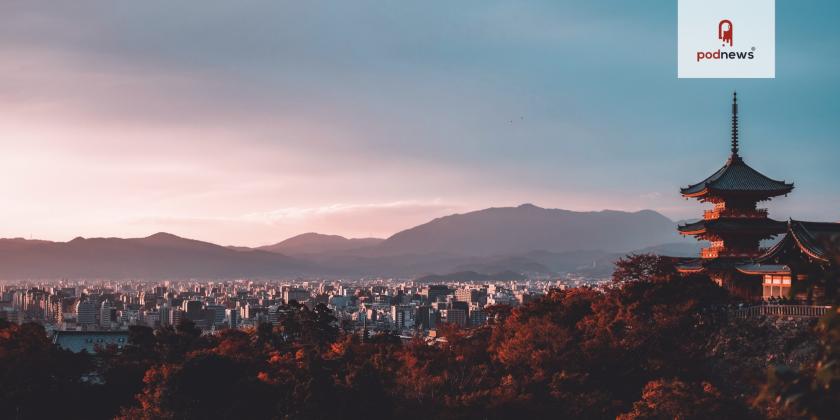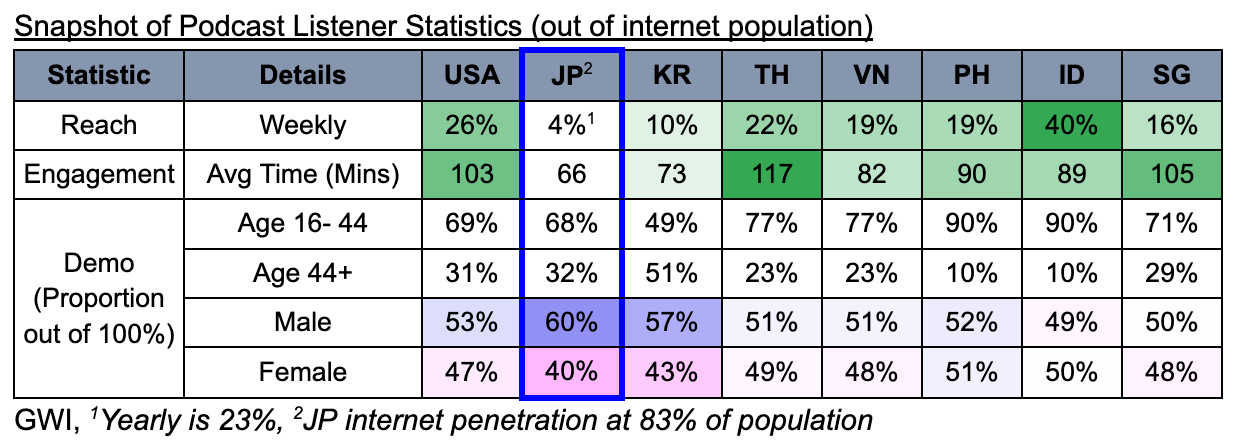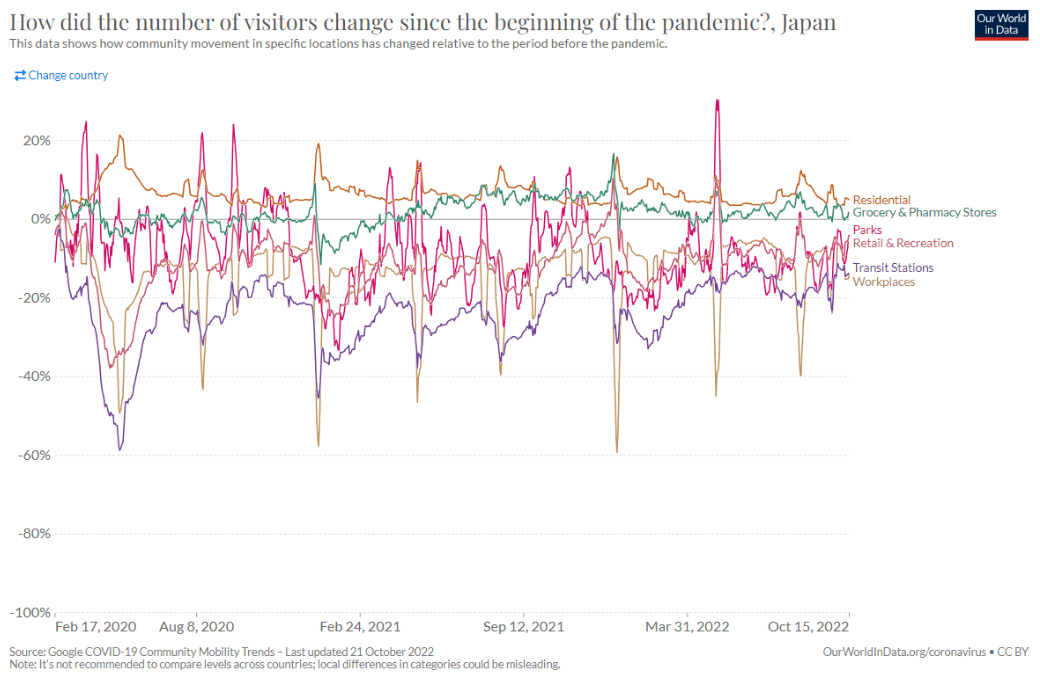
Japan: a podcasting deep-dive

This article is at least a year old
In the first of our deep-dives into different East and South East Asian podcast markets, we go to the home of the rising sun and of Twitter - but not a place where podcasting is incredibly popular, yet. Read on for the reasons why: and what Japanese podcast listeners are into.
What drives podcasting?
Before we can even discuss about JKAPAC’s deep-dive, we need to understand what drives podcast as a category. The hardside of content creation are usually the creators - the more creators you can get on board the platform, the more viewers you will naturally attract.
What attracts a creator differs by platform - on Youtube or Tiktok it is more metric driven, where creators produce for the algorithm, and are rewarded for it in views (and, sometimes, money). But for podcasting, where the barrier to enter is so low, a creator usually enters because they were inspired.
When we observe Serial, it no doubt attracted a large listener-base, but critically it kept the listeners by inspiring a whole swath of true crime podcasters. They in turn inspire the next, that birth an entire genre which kept new podcast listeners listening.
For a podcast to become a category driving podcast, we believe that they must give a reason for listeners to become a podcast creator.
Usually there’s 3 aspects to this:
- Are there local barriers that prevent one from being a content creator? Is the topic easy to reproduce via a podcast?
- Does the content have podcast superiority? Or put in another way - does removing visuals enhance the value of the production?
- Does the content capture the locality, trends and influences of the time?
The more often the answer is “Yes!” the more likely content is provided organically into the ecosystem, which eventually creates a category that drives podcast adoption.
Today in our deep-dive of Japan, we’ll first explorewhat stage is Japan for podcasting and its history; and then, what type of content can likely be a podcast category driver within Japan - ideally creating a Serial-like inflection.
Oh, and one more thing, we’ll share with you all the important metrics that you need - so if you love numbers like me, you’re in for a treat.
Recap
In our last article we explored the Japan Spotify Charts, and discovered two categories of podcasts that listeners seem to appreciate:
- Improving reality - Learning (English)
- Escaping reality - Comedy + Anime
We also learnt the unique local insight that drives this viewing behaviour; Japanese listeners are faced with a gloomy reality, as such seem to seek distractions or self-improvement to escape their current predicament.
But there’s a lot more to learn, here’s a snapshot of Japan’s podcast statistics vs the rest of the region.

You’ll notice two things:
- There are more male listeners (60%)
- Podcasts consumption is not popular in Japan. Japan has the lowest podcast weekly reach at 4% - 5x less than the US. For those who listen, they still listen the least duration in the region
Japan is actually at a stage fairly similar to where the west was during the pre-Serial era (pre-2014): dominated by comedians. In 2009, the Guinness World Record for the most downloaded podcast was held by an American comedian, Adam Carolla. He took the Guinness World Record from Ricky Gervais, a British comedian.
During this period, podcasts were not mainstream because they are driven by atomic networks - enclaves of fans that appreciate the work of a host.
For Japan they are at a similar stage because of the local comedy style; “Manzai” - which usually involves a duo of a serious comedian and a funny comedian who exchange witty statements quickly. Some of these jokes tend to be smutty, and we shouldn’t be surprised that more males consume it.
This rapid fire verbal dance also aligns very well with podcast as a medium, and might even perform better without appearances as listeners can imagine how funny the duo might actually look like.
But even then Japan’s weekly podcast reach is very depressed, largely because of many local barriers both hard and soft that prevent listeners from making the leap from listener to creator.
There are 3 hard barriers, the first is Radiko - an app that allows users to listen to 99 commercial radio stations with a single application. The shareholders of the app consist of major advertising agencies and Japan’s major radio stations. It was launched in 2010, 5 years before Spotify even allowed podcasts on their platform.
Naturally all old-school radio listeners migrate to Radiko, and radio stations keep airing within Radiko as opposed to repurpose popular programs into podcasts. This is a marked difference in the West, where radio networks entered podcasting as early as 2006 with This American Life, or 2004 with the BBC’s In Our Time.
The second hard barrier is the content laws surrounding Japan. Unlike the US, which allows fair use to some degree, many secondary sharing of copyrighted material is prohibited in Japan, unless you have the rights holder’s consent. This means if a video has 5 creators, each needs to provide you rights for usage which extends even to using subtitles. The team that enforces this, and pursues cases is the JASRAC, CODA, and numerous large media organisations that actively survey for infringement - a punishable offence for up to 10 years imprisonment (contrast the USA of up to 5 years). This barrier is not unique to podcasting which is why Youtube is also relatively depressed vs all other countries.

The third hard barrier is the language - English. Because most “How to guides” for podcasting are in English, a Japanese podcaster struggles more. A listener also has fewer options.
In terms of soft barriers they are fairly similar to the West; content creators are often viewed as a side-gig and not “worthy” of a main job. This perception is likely dialled up given that there are no aspirational global podcasters that prove to command a strong paycheck.
But is it all doom and gloom? Not exactly, TBS - Tokyo Broadcasting Station, the first radio broadcaster in Japan is planning to release a large number of new original podcast programs on all the mainstream podcast outlets - which means that they see value outside of Radiko. Covid also encouraged a surge of creators globally, including Japan which means more people are willing to tackle the complicated copyright laws and more people are willing to explain them to creators.
If you need a timeline on when we think the barriers will decline to become as low as the West, we predict around 8 - 10 years. Because high school boys now are starting to view Youtube as a legitimate option.
But right now, a success story is already in the making according to Taisuke Yagi, CEO of Japan audio advertising agency Otonal, who introduced me to Coten Radio, a very popular podcast to learn about history, done in a three-man talk show format. Originally a company that makes historical databases, they started podcasting for publicity on YouTube. The podcast turned into a revenue driving engine - and its business model today is through individual listeners’ donations/memberships and partnerships with corporate clients. Just last year, the independent company won one of the largest advertising awards in Japan beside Asahi Shimbun Publishing - one of the big three nationwide daily newspapers.
So it is a safe assumption that Japan will exit out of these barriers naturally, the question then is once barriers are relaxed what should we launch? Of course it’s impossible to predict the next “Serial”, but by looking at other unique content growth and media preferences we can make a good guess.

Immediately you’ll notice 1 very peculiar thing about Japan: Twitter is the top social media publisher.
There’s many reasons why Twitter is widely adopted but where our analysis is concerned:
“Anonymity
In Twitter reveals the truth
The truth of 2 lives.”
Like our Haiku?
Structurally Twitter’s constraint on word count is artistically similar to Haiku and Tankas, which drives the charm of using it. There’s always a feeling of artistry and challenge involved in delivering your message. Of course now the majority of Japanese people use Twitter for the network effect, but artistry is important.
The other factor is the high level of anonymity which allows one to really express their deepest thoughts - away from oppressive peer pressure. This need to express your innermost thoughts to feel authentic is a consequence of Tatemae, which is used in conjunction with Honne.
Honne or “True Sound” is meant to describe one’s true feelings and desires, while Tatemae or “Built in Front” is used to describe one’s public persona.
This duality is similar to the idea of a “corporate” side and a “personal” side. But Tatemae is taken to quite huge extremes which is why public apologies, resignations and sometimes even blatant lying to friends happen with such fanfare
Because the majority of a Japanese person’s time is dedicated to upholding their “front facing side”, it is unavoidable that “feeling authentic” now becomes a necessary outlet.
In Twitter it is estimated that some 75% of users are anonymous, while other markets are about half that number. Twitter’s acceptance to anonymous accounts is heaven-sent to any Japanese person who would love to share their real opinions, eventually building Japan’s Twitter into a forum, and even a search database for user’s real opinions and thoughts.
Twitter’s consolidation as a social media in JP reveals that content themes around artistry, anonymity and authenticity can command a huge audience.
Knowing this, we’ll work together and try to propose a podcast that might drive the category.

Here’s an example incorporating all the elements:
- Podcast: “My anonymous life - Famous people tell their less than famous stories”
- Format: Wrapped up in a 3 part episodic, each episode will have 3 segments partitioned by a quote that encapsulates the segment.
Format: Quote_1 | Yuki’s story_1 | Quote_2 | Yuki’s story_2 | Quote_3 | Yuki’s story_3
To imagine what an episode might look like, here’s an example: “Yuki Kashiwagi”, a member of AKB48 (a popular Japanese idol band with 72 members) could tell her anonymous story of what she lost to become an AKB48 idol, in an autobiography format.
Ep 1 Losing my Childhood Friend: _“A broken promise” | Segment_1 | “A lost friend” | Segment_2 | “Alone with my thoughts” | Segment3
Ep 2 My debut in the living room: _“My debut” | Segment_1 | “My Fan” | Segment_2 | “My Father” | Segment3
Ep 3 Back to Back: _“Smile because you are happy” | Segment_1 | “Smile when you’re sad” | Segment_2 | “Smile because it is not over” | Segment3 | Reveal
Why do we think this might work?
- Are there local barriers that prevent one from being a content creator? Outside of hard & soft barriers, as a topic it is easily replicated amongst different tiers of celebrities, and key opinion leaders. It can also be researched and individually produced as a one-man-show, and is not limited to who you know - just like how in True Crime there are narrations purely based on research (Serial Killers) or guest features (Crime Show).
- Does the content have podcast superiority? Or put in another way - does removing visuals enhance the value of the production? Yes, it has more anonymity without visuals, that may allow the guest to speak more freely.
- Does the content capture the locality, trends and influences of the time? While artistry is debatable. We believe yes, it allows truly authentic stories, but best of all it creates a duality amongst audiences - those who think they know and those who don’t. Those who think they do, will naturally be the loudest voices as they are fans and lead conversations outside of the podcast medium.
Of course this opens up a wormhole of conversation and debate, but our intent is not to design a show but to give you a good idea what a show that incorporates all these elements can look like.
There’s also some micro-optimisation that can be made for these programs, just like how splicing humour and True Crime can create “My Favourite Murder”. Unfortunately we couldn’t possibly cover the whole gamut of optimisations, but do follow us (subscribe to Podnews or read my linkedin) as we may release these optimisations from time to time.
Before we end things off, other interesting data worth showing to understand the landscape better:
Top listening platforms used amongst listeners (weekly) of podcasts
A tight battle between Spotify, Apple and Amazon…

What are Japanese doing while listening
The top 3 reasons in 2022 that Japanese listen to podcasts are (1) Before Bedtime, (2) When Walking, (3) Public Transport/ Driving Car. A year ago, in 2021 it was (1) Housework, (2) During hobbies, (3) Driving a Car/ Walking. It’s fascinating to see that Japan in 2021 is similar to US adults in 2022 - the majority listen while during housework.

2022, Otonal + The Asahi Shimbun Company. I highly recommend checking out https://otonal.co.jp/ to learn more about their study in detail.
Japan Mobility Data
Measured as a % against the 5-week period (Jan 3–Feb 6, 2020): Mobility in Japan is set to return to pre-covid levels, as more people are taking transportation again, since transit station movement is increasing back to baseline. While for most countries mobility signals increase in listenership, Japan still needs publishers to encourage habitual listening during commuting.

We hope the Japan deep-dive gave you some confidence to explore Japan as a market, and to be inspired to create more truly local content. If you need any help or want to have more discussions - do drop me a LinkedIn invite, I’m always excited for conversations!
Partners
This report was not easy to create, from translating articles to finding the unique local key opinion leaders to contribute.
Quite frankly I’m blessed that somehow, everyone came together to help. Firstly, special thanks to GWI for allowing us to dive into their rich dataset - whatever we’ve shown in the report is only a drop in their ocean of data. If you want to see more here’s their contact, make sure to tell them that I sent you!
Secondly, thanks to all our country partners below. These partners were all consulted to varying degrees to understand if our assumptions make sense. They also provided key landscape data, information and content from a local perspective:
- Tim Romero - Tim is Head of Google for Startups Japan and host of the Disrupting Japan podcast. He is deeply involved in Japan’s startup community as an investor, founder, author and educator, and has founded several startups in Japan over the past 25 years. He has also taught entrepreneurship and corporate innovation at NYU’s Tokyo campus and worked with TEPCO and other Japanese enterprises on startup engagement and innovation strategy.
- Matt Alt - Matt is the author of Pure Invention: How Japan Made the Modern World, and founder of AltJapan Co. Ltd, a company that specialises in localisation of Japanese to English and vice versa across all forms of entertainment.
- Serkan Torso - Cofounder of ByFood. ByFood is Japan’s one-stop platform for foodie travellers. You can book food experiences like cooking classes and food tours, make easy restaurant reservations without using Japanese, and order products from local businesses. We also provide online experiences, blogs about Japanese food trends and culture, and videos featuring Japanese chefs and craftspeople.
- Taisuke Yagi, from Otonal. Otonal is a voice advertising company of “Oto” x technology that develops digital voice advertising business. With over 32 clients, including names like Yamaha, Daiso, Sapporo - with delivering excellent client results through audio. We at Otonal aim to expand the possibilities of voice and communication in the digital voice market.
































































































